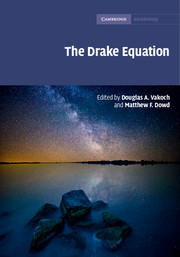Book contents
- The Drake EquationEstimating the Prevalence of Extraterrestrial Life through the Ages
- Cambridge Astrobiology
- The Drake Equation
- Copyright page
- Dedication
- Contents
- Contributors
- Foreword
- Preface
- Book part
- Introduction
- 1 Rate of formation of stars suitable for the development of intelligent life, R*, pre-1961
- 2 Rate of formation of stars suitable for the development of intelligent life, R*, 1961 to the present
- 3 Fraction of stars with planetary systems, fp, pre-1961
- 4 Fraction of stars with planetary systems, fp, 1961 to the present
- 5 Number of planets, per solar system, with an environment suitable for life, ne, pre-1961
- 6 Number of planets, per solar system, with an environment suitable for life, ne, 1961 to the present
- 7 Fraction of suitable planets on which life actually appears, fl, pre-1961
- 8 Fraction of suitable planets on which life actually appears, fl, 1961 to the present
- 9 Fraction of life-bearing planets on which intelligent life emerges, fi, pre-1961
- 10 Fraction of life-bearing planets on which intelligent life emerges, fi, 1961 to the present
- 11 Fraction of civilizations that develop a technology that releases detectable signs of their existence into space, fc, pre-1961
- 12 Fraction of civilizations that develop a technology that releases detectable signs of their existence into space, fc, 1961 to the present
- 13 Length of time such civilizations release detectable signals into space, L, pre-1961
- 14 Length of time such civilizations release detectable signals into space, L, 1961 to the present
- Afterword
- Index
- References
Introduction
The Drake Equation in context
Published online by Cambridge University Press: 05 July 2015
- The Drake EquationEstimating the Prevalence of Extraterrestrial Life through the Ages
- Cambridge Astrobiology
- The Drake Equation
- Copyright page
- Dedication
- Contents
- Contributors
- Foreword
- Preface
- Book part
- Introduction
- 1 Rate of formation of stars suitable for the development of intelligent life, R*, pre-1961
- 2 Rate of formation of stars suitable for the development of intelligent life, R*, 1961 to the present
- 3 Fraction of stars with planetary systems, fp, pre-1961
- 4 Fraction of stars with planetary systems, fp, 1961 to the present
- 5 Number of planets, per solar system, with an environment suitable for life, ne, pre-1961
- 6 Number of planets, per solar system, with an environment suitable for life, ne, 1961 to the present
- 7 Fraction of suitable planets on which life actually appears, fl, pre-1961
- 8 Fraction of suitable planets on which life actually appears, fl, 1961 to the present
- 9 Fraction of life-bearing planets on which intelligent life emerges, fi, pre-1961
- 10 Fraction of life-bearing planets on which intelligent life emerges, fi, 1961 to the present
- 11 Fraction of civilizations that develop a technology that releases detectable signs of their existence into space, fc, pre-1961
- 12 Fraction of civilizations that develop a technology that releases detectable signs of their existence into space, fc, 1961 to the present
- 13 Length of time such civilizations release detectable signals into space, L, pre-1961
- 14 Length of time such civilizations release detectable signals into space, L, 1961 to the present
- Afterword
- Index
- References
Summary
The Drake Equation, a method for estimating the number of communicative civilizations in the Milky Way galaxy, was a product of its time in several important ways. After a period of several decades during which the idea of life on other planets had reached a low point due to rise of the “rare collision” hypothesis for planet formation, by the 1950s the nebular hypothesis was once again in favor, whereby planets would form as a common byproduct of stellar evolution. The Miller–Urey experiments in the early 1950s produced complex organic molecules under simulated primitive-Earth conditions, indicating life might easily originate given the proper conditions. And while little was known about the gap between primitive life and intelligent life, and a sophisticated understanding of intelligence was lacking, the Lowellian Mars still lingered in the cultural background and, along with contemporary astronomical advancements, stimulated the scientific imagination to consider aliens. The original emphasis on “radio communicative” reflected the new era of radio astronomy, exemplified by the radio telescopes under construction at the newly founded National Radio Astronomy Observatory (NRAO) in Green Bank, West Virginia, where Frank Drake was working at the time when the equation originated as the meeting agenda for an informal conference there in 1961. Drake's ability to undertake such a controversial subject, including the first radio search for extraterrestrial intelligence in 1960, was aided by senior scientists Lloyd Berkner and Otto Struve. Assessments of the probabilities of extraterrestrial life and intelligence had been sporadically undertaken in the course of the twentieth century, but most particularly by former Harvard Observatory Director Harlow Shapley in his book Of Stars and Men (1958); Drake had recently graduated from the Harvard astronomy program, and had cited the book. Here we look at the origins and development of the equation over time, including significant variations in the equation; examine positive and negative views of its epistemological status and utility ranging from scientists to popular authors such as Michael Crichton; and attempt to tease out the scientific and metaphysical assumptions behind the equation. We conclude by discussing the future of the equation, and the cultural hopes and fears it embodies.
- Type
- Chapter
- Information
- The Drake EquationEstimating the Prevalence of Extraterrestrial Life through the Ages, pp. 1 - 20Publisher: Cambridge University PressPrint publication year: 2015

